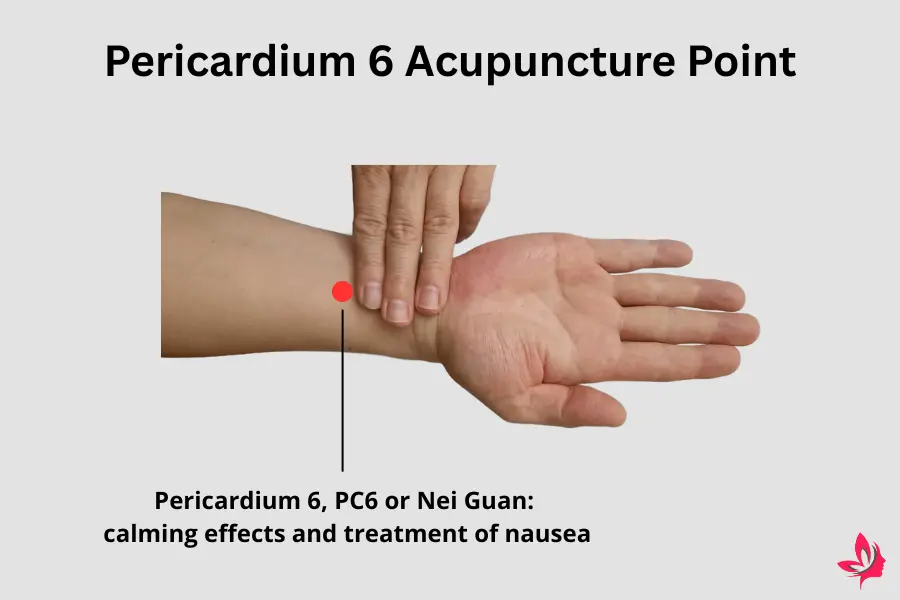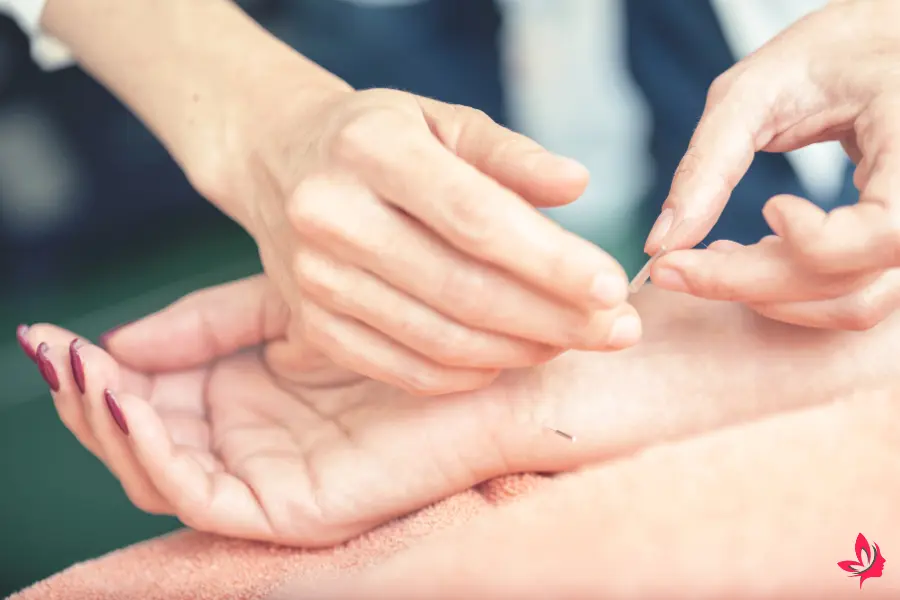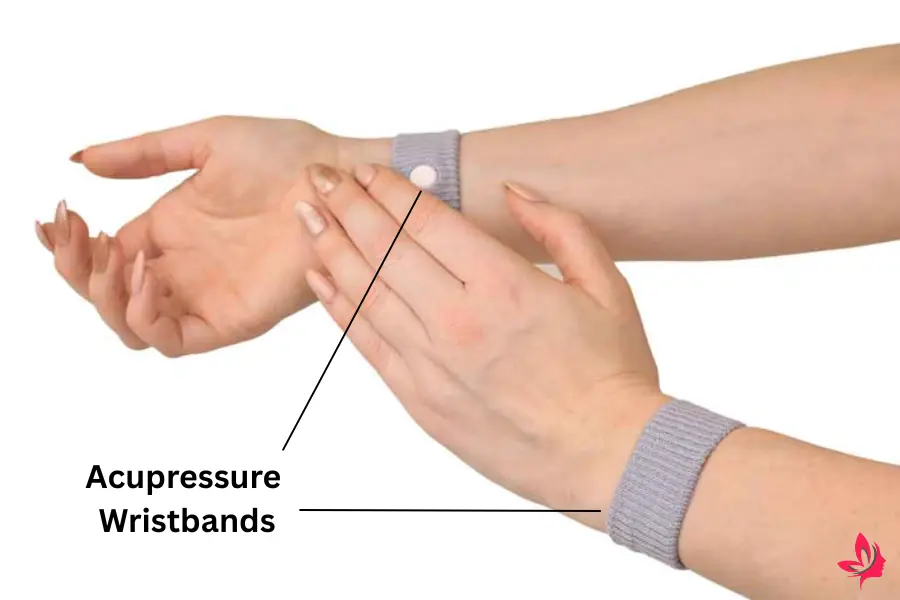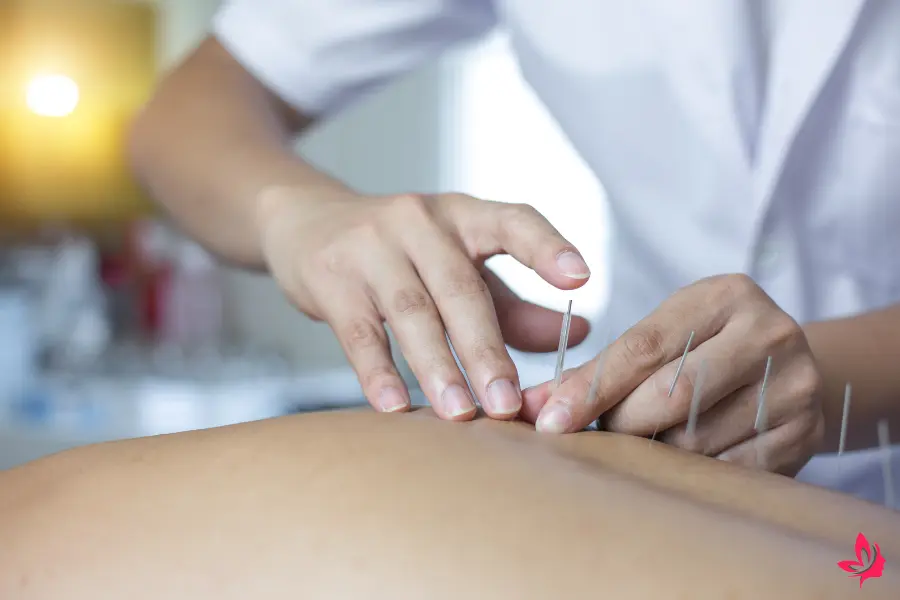Pericardium 6 acupuncture point, PC6 or Nei Guan, has been a go-to remedy for nausea relief. Many struggle with nausea, whether due to motion sickness, pregnancy, or medical treatments, and finding effective relief is vital.
Located on the inner wrist, this pressure point can significantly reduce nausea and vomiting when stimulated correctly.
This specific acupuncture point has been widely researched for its effectiveness in calming the body’s qi, or energy, alleviating uncomfortable symptoms connected to nausea.
Studies have shown that using acupressure or acupuncture on this point can be as effective as some antiemetic drugs, enhancing comfort without medication side effects.
Research supports the combination of PC6 acupoint stimulation with traditional therapies to achieve better outcomes than medication alone.
Learning about the pressure point through reliable resources can empower individuals to manage their symptoms. The Yinova Center suggests that PC6 helps in descending qi, aiding in better energy flow within the body.
By understanding this ancient practice, people can take charge of their wellness, utilizing a blend of modern science and traditional wisdom.
What is the Pericardium 6 Acupuncture Point?

The Pericardium 6 acupuncture point is on the inner wrist and offers therapeutic benefits.
It is an integral part of the pericardium channel, which plays a role in traditional Chinese medicine. Historically, it has been used to relieve symptoms such as nausea and chest pain.
Location on the Inner Wrist
Pericardium 6, or Nei Guan, is positioned on the inner arm, approximately two or three finger widths from the wrist crease. It sits between the tendons of the palmaris longus and flexor carpi radialis.
This acupressure point is often used for its calming effects and treatment of nausea related to motion sickness or morning sickness.
Individuals can stimulate this point by applying small circular motions or acupressure wristbands.
Relation to the Pericardium Channel
In traditional Chinese medicine, the pericardium channel is associated with the heart protector. It is significant for maintaining the flow of qi, or energy, throughout the body, which is crucial for emotional and physical health.
Pericardium 6 connects with parts of the parasympathetic nervous system and influences the vagus nerve. This interaction can help alleviate symptoms such as chest tightness and stomach pain by promoting relaxation and healing.
Historical Context in Traditional Chinese Medicine
In traditional Chinese medicine, Pericardium 6 has been used for centuries to address various ailments, particularly those related to the heart and stomach. It is considered part of the eight extraordinary vessels and is known for its effectiveness in treating nausea and supporting treatment for sea sickness and postoperative conditions.
Additional research studies highlight its promising role in managing abdominal pains and alleviating poor memory symptoms.
How Pericardium 6 Relieves Nausea

Pericardium 6, the Nei Guan acupressure point, is located on the inner forearm about three finger widths up from the wrist crease. Stimulating this point can help alleviate nausea by interacting with the vagus nerve, proving effective for conditions like motion sickness.
Mechanism of Action on the Vagus Nerve
The Pericardium 6 acupuncture point is connected to the vagus nerve, a key part of the parasympathetic nervous system.
When stimulated, it can help regulate heart rate and blood pressure while promoting relaxation. This calming effect on the body can decrease the incidence of nausea.
Stimulation of Pericardium 6 can involve pressing the point firmly or using small circular motions.
Techniques such as acupressure wristbands or self-massage have been shown to activate this point, potentially reducing nausea symptoms and aiding digestive health.
Effectiveness for Motion Sickness and Sea Sickness
Pericardium 6 is widely recognized in traditional Chinese medicine for its effectiveness in reducing motion sickness and sea sickness symptoms.
Studies indicate that applying pressure on this point helps relieve travel-related nausea.
Acupressure wristbands are one popular method for continuous stimulation, particularly for travelers.
These wearable solutions apply pressure using small beads or magnets, ensuring consistent point activation.
This method is beneficial for preventing nausea during long journeys, showing significant promise for those who experience chronic travel-related discomfort.
Research Studies and Recent Findings
Recent studies have explored the use of Pericardium 6 for treating nausea, revealing positive outcomes.
A systematic review of multiple trials supports its effectiveness in reducing postoperative nausea and vomiting, a common issue following surgeries like laparoscopic cholecystectomy.
In clinical settings, the use of Pericardium 6 has been compared with conventional rescue antiemetics, and in some cases, it has shown similar or superior results.
Further studies are needed to understand its full potential better, but current findings suggest it holds promise for broader applications in nausea management.
Techniques for Stimulating Pericardium 6

The Pericardium 6 (PC6) acupuncture point, located on the inner wrist, is used in traditional Chinese medicine to help relieve nausea and vomiting.
Stimulating this point has been found beneficial for conditions including motion sickness and morning sickness.
Using Acupressure Wristbands
Acupressure wristbands are a popular and convenient method for stimulating the PC6 point.
These bands are designed to apply consistent pressure at the correct location on the inside of the wrist. They are especially effective for individuals experiencing motion sickness or morning sickness.
Positioned about three finger widths from the wrist crease, they are often equipped with a small plastic stud that presses directly onto the PC6 point.
They offer a drug-free alternative, making them suitable for those who prefer non-pharmaceutical interventions.
These wristbands can be worn discreetly and are ideal for travel or daily use.
Acupressure Self-Massage Techniques
Self-massage of the PC6 point involves using fingers to apply pressure to the area on the wrist.
Measuring approximately three finger widths from the wrist crease between the palmaris longus tendons and flexor carpi radialis to locate it.
Individuals can apply firm pressure and perform small circular motions using the thumb or index finger.
This technique helps manage symptoms of nausea and chest pain.
Taking deep breaths while massaging can enhance the calming effect.
It is a simple technique that does not require special tools, making it accessible for personal health management.
Application of Acupressure Magnets
Applying acupressure magnets offers another effective way to stimulate the PC6 point.
Magnets can provide continuous pressure and enhance blood flow at the site.
By placing these magnets directly on the acupressure point, users experience the beneficial effects without constantly applying manual pressure.
This technique may reduce the incidence of nausea during treatments like chemotherapy or surgery.
Before using acupressure magnets, consulting with a healthcare provider can ensure they are suitable for individual needs, especially for those with pacemakers or similar devices.
Benefits Beyond Nausea Relief

The Pericardium 6 acupuncture point, or Nei Guan, offers several benefits beyond alleviating nausea.
It helps relieve chest pain, reduces tightness, and promotes relaxation by improving blood flow. These positive effects are rooted in its location and connections within the body.
Alleviating Morning Sickness and Postoperative Nausea
The Pericardium 6 acupuncture point, located about three finger widths from the wrist crease, is often used for reducing nausea from morning sickness and postoperative recovery.
Studies suggest pregnant women may experience less morning sickness when using acupressure wristbands targeting this point.
Additionally, research studies show a decrease in postoperative nausea when this point is massaged.
By focusing on the inner forearm, individuals can apply consistent pressure to help manage nausea efficiently.
Reducing Chest Pain and Chest Tightness
The Pericardium 6, positioned between the tendons of the palmaris longus and flexor carpi radialis, is linked with reducing chest pain and tightness.
This acupuncture point connects to the heart protector channel, easing symptoms like tightness and discomfort in the chest, possibly related to stress or anxiety.
By gently pressing on the inner arm, users may find relief from these symptoms, supporting traditional Chinese medicine approaches and enhancing well-being.
Promoting General Relaxation and Blood Flow
Nei Guan also plays a role in promoting relaxation and improving blood circulation.
Stimulating this point balances the nervous system, offering a calming effect on the body.
It influences the part of the parasympathetic nervous system responsible for relaxation.
Acupressure self-massage at this point can aid in stress relief and enhance overall relaxation by promoting blood flow. It can also support those with high stress levels or who seek calmness in daily life.
Practical Tips for Using Pericardium 6

Pericardium 6, the nei guan acupressure point, can effectively manage nausea and vomiting. This section will guide readers on efficiently locating and utilizing this point for various conditions, including motion and morning sickness.
Identifying the Exact Point Locations
Locating the Pericardium 6 acupuncture point is essential for effective acupressure. This point, situated on the inner arm, lies between the tendons of the palmaris longus and flexor carpi radialis. It is about three finger widths from the wrist crease.
Accurate identification of this spot can help alleviate symptoms linked to the pericardium channel, such as nausea and chest pain. Consistent application at precisely identified points allows for enhanced therapeutic benefits.
Using Finger Widths to Find the Inner Gate
Employing finger widths helps to find the inner gate, or Pericardium 6 point precisely.
Measuring about three finger widths from the inside of the wrist toward the elbow provides a reliable method for locating this acupressure point.
Use the index, middle, and ring fingers to gauge this distance. Well-located and massaged areas using small circular motions can significantly benefit people experiencing symptoms associated with the inner forearm and wrist area.
Consulting with a Healthcare Provider for Best Practices
Before starting acupressure sessions, consulting a healthcare provider can offer important insights into best practices.
A healthcare professional can guide the use of acupressure wristbands or magnets and advise on more complex cases, such as postoperative nausea or poor memory.
They ensure that the method aligns with existing medical treatments and that the healthcare provider’s techniques are tailored to individual needs.
This step helps reduce the risk factors associated with self-treatment of nausea and enhances the beneficial effects of acupressure.
Final Thoughts
The Pericardium 6 acupuncture point, often referred to as PC6 or Neiguan, offers a simple technique for potentially relieving nausea.
This point is located on the inner forearm near the wrist and is accessible and easy to find.
Pressing the PC6 point may help manage symptoms related to nausea. These symptoms can be caused by motion sickness, pregnancy, or medical treatments like chemotherapy.
Acupressure on this point also calms the mind and may reduce feelings of anxiety.
Studies highlight its effectiveness in easing nausea, making it a helpful tool for many people.
Alongside medical advice, acupressure can be a handy addition to your wellness toolkit.
Key Takeaways
- The PC6 point is located on the inner forearm.
- It can relieve various types of nausea.
- Using PC6 may help reduce anxiety and promote relaxation.
Trying out acupressure on the Pericardium 6 point is a non-invasive way to seek relief. Understanding its potential benefits could complement conventional methods and enhance overall well-being.
Frequently Asked Questions
Pericardium 6, also known as PC6, is an acupuncture point often used to alleviate nausea and other related symptoms. Its effectiveness in these areas has drawn attention to its function and location.
Where is the pericardium 6 acupuncture point?
Pericardium 6 is located on the inner arm, about three finger widths below the wrist between the two tendons. This point is commonly activated to relieve nausea and vomiting.
What are the benefits of pericardium 6?
PC6 is known for relieving nausea, vomiting, and motion sickness. It may also help with anxiety and stress by calming the mind and promoting relaxation.
What are the five forbidden acupuncture points?
These points are generally avoided during pregnancy as they might stimulate contractions or have other side effects. For safety, it is recommended that you consult a professional before proceeding with such treatments.
Does the P6 pressure point actually work?
Many studies and anecdotal evidence suggest stimulating the P6 point can reduce nausea. This is especially true in cases of motion sickness and morning sickness during pregnancy.
Proper technique and pressure application are important for the best results.
What is pericardium 6 acupressure for panic attacks?
PC6 is believed to help with panic attacks by promoting a calming effect and reducing stress. Its location near the heartline may contribute to its effectiveness in easing anxiety symptoms.
What is the function of the PC6 point?
PC6 primarily aids in the body’s movement and balance of qi (energy). This facilitates relief from nausea, vomiting, and motion sickness, as it helps stabilize bodily functions.
What is the key acupressure point in dealing with acid reflux called pericardium 6 or P6?
PC6 is sometimes recommended for managing acid reflux symptoms due to its role in harmonizing the stomach and digestive system. Stimulating this point might help reduce discomfort and improve overall digestion.
Where is the PC6 TCM located?
In Traditional Chinese Medicine, PC6 is located on the pericardium meridian and plays a vital role in regulating heart and chest functions.
It is situated on the wrist and is easily accessible for both acupuncture and acupressure.
Where to massage to relieve anxiety?
Massaging the Pericardium 6 points can help relieve anxiety.
To achieve calming effects, it is recommended to apply gentle pressure to this point while breathing deeply. Other points, like Shen Men (HT7), can also be beneficial.
What are the acupressure points for pericardium?
Besides PC6, other pericardium acupressure points include PC7 and PC8. These points are part of the pericardium meridian. They have functions that support cardiac health and emotional well-being.
Each point has distinct qualities that complement their overall therapeutic effects.




